The long, hot summer of 2025 has been something else, right? Hate rallies, creeping authoritarianism, a weird reluctance to discuss the extremity of the weather even as everyone scrambles to buy air conditioners...
But also a slightly delirious sense of fun as people get out and about in the sun – exemplified by the eruptions of joy of DJ AG’s spontaneous pavement sets featuring unknowns and megastars, broadcast online as a super-democratic antidote to all those videos of DJs alone or surrounded by too-cool-for-school party people.
Anyway, it’s all quite exhausting. I was feeling burned out and quite wary about the idea of being booked to appear at two dancing-oriented festivals in two weekends, the first of which features multiple 24-hour soundsystems. Houghton Festival in North Norfolk is the creation of Craig Richards, much-beloved resident DJ of fabric for over 25 years, and like fabric it is for people who take partying very seriously. Lots of people dressed (or undressed) to dance – with a notably high representation of Scousers and Italians – were clearly ready to sleep very little for four days, and most of the stages were pounding out some variation on house or techno for most of the time.
 But even just taken on that level, it’s a cut above: soundsystems and production values were spectacular even on the smaller stages (pictured right by Khali Ackford), the festival makes the most of Houghton House’s woodland (a blessed relief when the sun is blasting), and most importantly of all it’s a celebration of DJ culture and pretty much every single person playing, day or night, had skills that reminded me of what that craft is all about. Never about the flashy transition designed for “Instagram moments”, nor about functional monotony, each one truly played with their records and the blends between them, creating subtle surprises and grand arcs, the groove paramount but with plenty of room for flourish and colour. Somehow the event as a whole channelled all the energy of old-school raves, only with security, toilets and campsites all run like clockwork.
But even just taken on that level, it’s a cut above: soundsystems and production values were spectacular even on the smaller stages (pictured right by Khali Ackford), the festival makes the most of Houghton House’s woodland (a blessed relief when the sun is blasting), and most importantly of all it’s a celebration of DJ culture and pretty much every single person playing, day or night, had skills that reminded me of what that craft is all about. Never about the flashy transition designed for “Instagram moments”, nor about functional monotony, each one truly played with their records and the blends between them, creating subtle surprises and grand arcs, the groove paramount but with plenty of room for flourish and colour. Somehow the event as a whole channelled all the energy of old-school raves, only with security, toilets and campsites all run like clockwork.
Thankfully for the tired and burned out among us, there was so much more to the festival too. Dotted around the perimeter were spaces for talks (pictured below - all other photos by Sienna Gray), chilling out, jazz, classical, global and avant-garde minimalism performance and more, and even between the fearsome techno in the constantly dark space of the literally-named Warehouse space there were interludes of experimental electronic soundscapes and even cosmic chamber music with ensemble including harp, cello and singer (Ricardo Romaneiro’s gorgeous drone piece “Resonant Earth” with vast projection of our planet’s night side surface rotating slowly in the background).
Ambling around without a schedule I stumbled on surprise gems at every turn. Japanese hip hop scratching and production legend DJ Krush turning the kind of ultra-modernist jump-up drum’n’bass beloved of rabid teenagers into an entirely new style by cutting and layering it on the fly. A full-on and brilliant mid-afternoon techno set by Munich’s Polygonia suddenly switching to the abstract surround sound electronic forms of Duchamp-loving Californian Rrose’s live set. The Greg Paulus Live Ensemble in a small bar somehow perfectly capturing the spirit of the deepest of house music even as they were playing jazz. South African band BCUC’s 200bpm pounding, deep soul and death metal screaming whipping the Sunday crowd into a frenzy.
 Experimental bass music veteran dBridge DJing a set of his own slower productions including spooky and dubbed out reworks of soul songs by the made for a mid-morning treat. Mid-afternoon, the remarkable Fergus Quill Trio from Leeds made a glorious racket veering easily from Mingus-y blues to deranged abstract, instrument-swapping Dada improv clatter and back as easily as breathing. Al Wooton, normally known for glossy high tech club sounds, played a set of global music taking in Bhangra, dub, postpunk, North African sounds and more all blended into a whole with uncanny skill. Likewise a live set from Peter Adjaye’s Music For Architecture combo had a trans-global feel but with kora, tabla, DJ cuts and jazz vocals it felt like an update on Don Cherry’s utopian visions.
Experimental bass music veteran dBridge DJing a set of his own slower productions including spooky and dubbed out reworks of soul songs by the made for a mid-morning treat. Mid-afternoon, the remarkable Fergus Quill Trio from Leeds made a glorious racket veering easily from Mingus-y blues to deranged abstract, instrument-swapping Dada improv clatter and back as easily as breathing. Al Wooton, normally known for glossy high tech club sounds, played a set of global music taking in Bhangra, dub, postpunk, North African sounds and more all blended into a whole with uncanny skill. Likewise a live set from Peter Adjaye’s Music For Architecture combo had a trans-global feel but with kora, tabla, DJ cuts and jazz vocals it felt like an update on Don Cherry’s utopian visions.
The truly extraordinary thing was that the full-on party people all engaged with these sets with gusto. Where I’d half expected them to serve as background music for people taking a rest in the seated areas, or to be for the older parts of the crowd, in fact people of all ages including ones who seemed to have been dancing for days were really keyed in to the weirdest sounds – and into the panel talks like the ones I was there to do. During deep discussions about German experimental music and UK soundsystem culture, I again wondered if the people sprawled on benches were just there to rest – but the questions at the end of each were incisive, even inspiring, and I got emails afterwards from crowd members who’d been spurred to further research and action. If Houghton overall is an upgraded rave, these zones were like an update on the classic chillout room where unexpected conversations sprawl out through days and nights.
So, a couple of days recuperation, then on to Dorset for We Out Here. As I’ve detailed in previous years’ reports, WOH is a more diverse festival in all senses, and that continued this year. There was still a lot of pounding dance music, on even better soundsystems, but only (!) until 4am, but there was also a lot more live music and Glastonbury-ish attractions (pictured below) like craft and book markets, saunas, lake paddleboarding, kids' drumming workshops, foraging expeditions, a dazzling array of food stalls from around the world from Trinidad to Turkmenistan – plus, for the first time this year, a five-star dining tent with a different big name guest chef each year. Yet somehow it manages to avoid any whiff of post-Cath Kidston Cotswold winnebago vibes, thanks to the sheer commitment of all participants – both to the music and culture of the event, and to making it into a party.
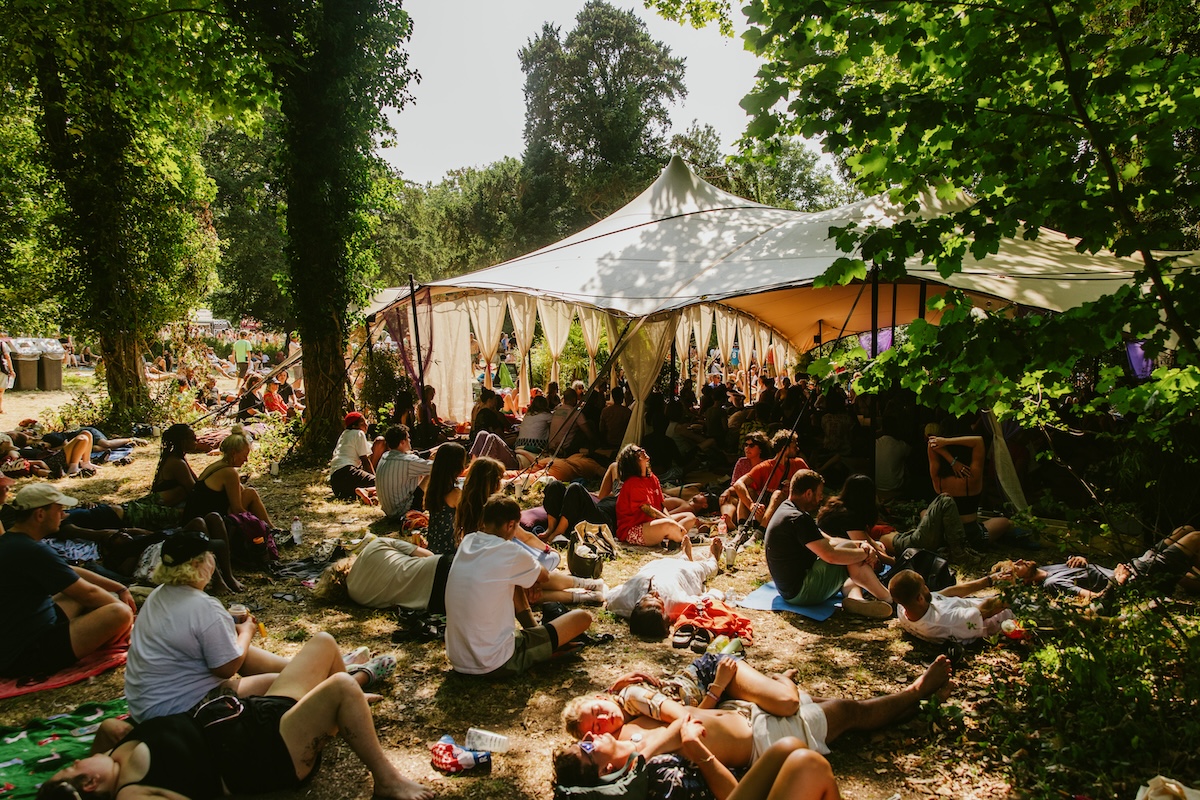 Again it seemed like there was unexpected joy round every corner. As ever, festival founder Gilles Peterson gets vintage names who can still deliver: 74-year-old reggae legend Horace Andy may have slightly soured his peace-and-love rhetoric by directing some serious menace toward the soundperson when bass feedback interrupted him but his performance was world class. Later 72-year-old Leroy Burgess delivered his disco-funk with an incredible band, fizzing with delight as if the songs were written yesterday. And carrying on the torch from older musician, Rotary Connection 222 – founded by the daughters of cult arranger and producer Charles Stepney – produced a near flawless set of songs Rotary Connection and related musicians like Minnie Riperton had made famous.
Again it seemed like there was unexpected joy round every corner. As ever, festival founder Gilles Peterson gets vintage names who can still deliver: 74-year-old reggae legend Horace Andy may have slightly soured his peace-and-love rhetoric by directing some serious menace toward the soundperson when bass feedback interrupted him but his performance was world class. Later 72-year-old Leroy Burgess delivered his disco-funk with an incredible band, fizzing with delight as if the songs were written yesterday. And carrying on the torch from older musician, Rotary Connection 222 – founded by the daughters of cult arranger and producer Charles Stepney – produced a near flawless set of songs Rotary Connection and related musicians like Minnie Riperton had made famous.
But it was absolutely just as much about young talent as diverse as the crowd. Polish ambient harpist Marysia Osu provided one of the greatest lunchtime moments on the main stage, drawing in passers-by to a crowd which grew throughout her set. Indian-American polymath Ganvya completely entranced a much larger crowd still with her new generation reaffirmation of John and Alice Coltrane’s Hindu jazz cosmology. Rappers Lex Amor, Pa Salieu and Bashy provided pure poetry, militant dancehall grooves and proud life lessons respectively. Not quite so young, but still super hungry for the new, Richard Russell’s Everything is Recorded project did an extraordinary job of recreating the dreamlike collage-like atmosphere of their records with samples and live band interwoven virtuosically.
And DJs were everywhere, playing at every tempo and level of syncopation. In The Bowl area (pictured below), forefathers of “the Bristol sound” Smith & Mighty made us feel like we were at St Paul’s Carnival with a wonderfully genial sense that the various MCs and singers joining their breakbeats and dub bass were probably their neighbours and cousins. In the same spot Sheffield-via-Manchester national treasure Luke Una brought mischievous party vibes as he miraculously made West African slow disco groovers work alongside sleazy 80s Euro sex dungeon club sounds and Latin carnival pop. Perhaps best of all in The Bowl, though, was Ghanaian Brit Karen “KG” Nyame who played Afro house that never wavered from its solid groove even as it brought in waves of R&B, super-heavy bass, sensuous synth and all kinds of other influences. With her militant MC hollering “all the queers to the front!” it felt like a reinvention of house music from all its original first principles, and it was impossible to leave for the whole 90s minutes.
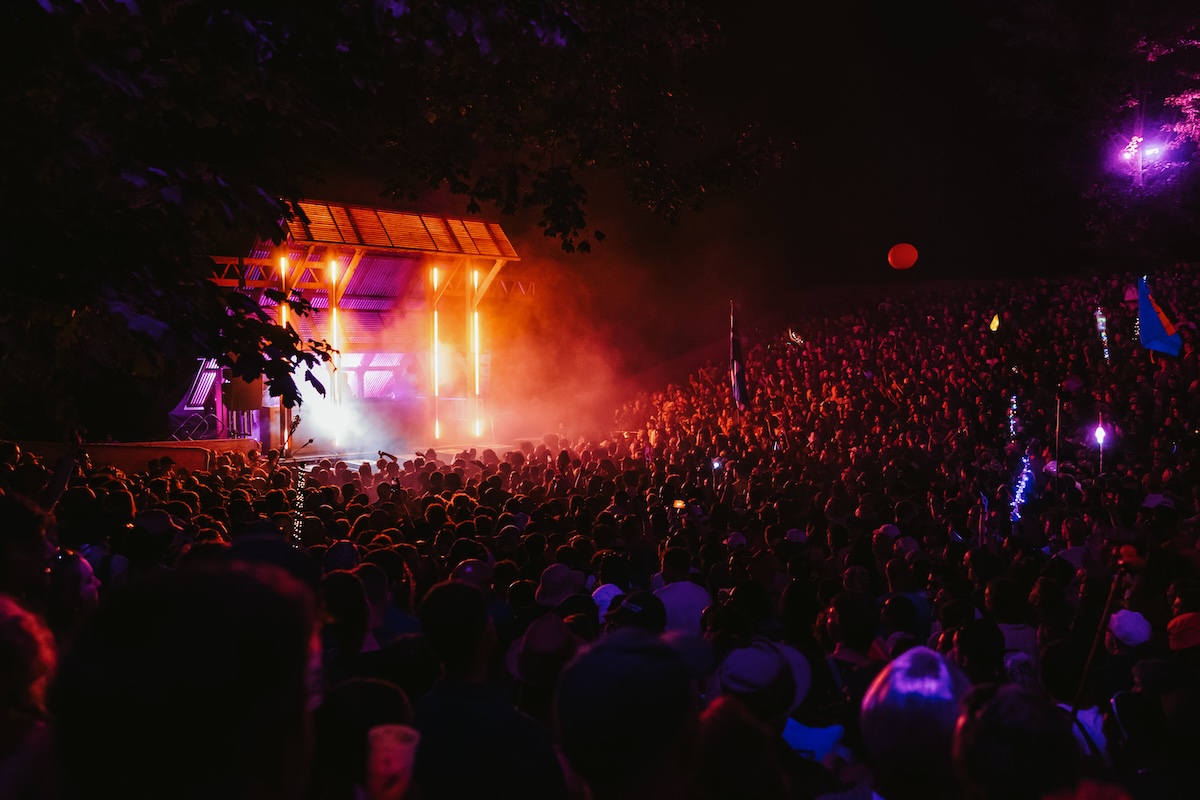 Colleen “Cosmo” Murphy’s Love Dancing tent with its sprung dancefloor was relentlessly great as ever (aided by the fact that open on three sides it caught the breeze and provided respite from the heat, even on the Friday when it was getting too much for us elsewhere). Manchester’s Mr Scruff filled a whole day with back-to-back sets with serious talents, highlights including Cuban selector Cami Layé Okún and London-via-Leeds turntablist talent NikNak who provided a festival highlight with a bootleg that turned Sade Afro-Latin. Underground and overground trouper of many decades standing François Kevorkian blew us away with a set of live on-the-fly “stems” remixes of disco and funk classics, making familiar grooves new and strange – though I had to miss his later, higher energy still, 1-4am set as I was playing decadent ambient and film soundtrack sounds in a Moroccan-style tea-tent to very relaxed crowd in a scene that a stranger later described, to my delight, as “Fellini-esque”.
Colleen “Cosmo” Murphy’s Love Dancing tent with its sprung dancefloor was relentlessly great as ever (aided by the fact that open on three sides it caught the breeze and provided respite from the heat, even on the Friday when it was getting too much for us elsewhere). Manchester’s Mr Scruff filled a whole day with back-to-back sets with serious talents, highlights including Cuban selector Cami Layé Okún and London-via-Leeds turntablist talent NikNak who provided a festival highlight with a bootleg that turned Sade Afro-Latin. Underground and overground trouper of many decades standing François Kevorkian blew us away with a set of live on-the-fly “stems” remixes of disco and funk classics, making familiar grooves new and strange – though I had to miss his later, higher energy still, 1-4am set as I was playing decadent ambient and film soundtrack sounds in a Moroccan-style tea-tent to very relaxed crowd in a scene that a stranger later described, to my delight, as “Fellini-esque”.
There was more – so, so much more – including a deluge of jungle, drum'n'bass, dubstep, footworking and other futurist bass genres (or, in the hands of DJ Neffa-T all of them mixed together with blinding skill). With both, abundance was the point, as they bubbled over with pride in their talent pools. But then, just as with Houghton, the curation was led by someone at the dead centre of the scene the festival represented, and the music they and their teams gathered was practically by definition plugged into the tastes of their crowd. There was quite a bit of overlap between the two, with some DJs playing both, but there was also a clear separation. But whether it was – as I overheard a lively Scouser putting it – “all the sound party heads” at Houghton, or the somewhat more laid-back, politically conscious, soulful crew of WOH, the crowd was as vital to the festival as the programming and infrastructure.
Were they perfect? Well I’d certainly have liked more food options at Houghton (though that’s not most people’s priority there), and WOH need to have a word with whatever contractor was (or frequently wasn’t) emptying their toilets this year – and if these scarily warm years continue, will need to give serious thought to how much open space there is. But these things are tinkering round the edges. With WOH in its sixth year and Houghton in its ninth both have shown that it’s possible to build an independent event that crystallises a very particular subculture and network of people into something way more participatory, celebratory and nourishing to the self and society than the standard cattle-pens and Carling festival industrial complex can ever imagine. Ludicrously, after two long weekends on the trot, I came out of WOH with more vim and verve in my heart than a fortnight beforehand.







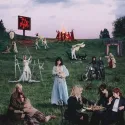

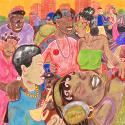

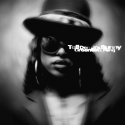


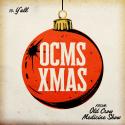
Add comment